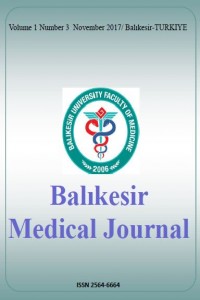Öz
Objective: We aimed to evaluate the
histopathological and endoscopic features of colorectal polypectomy cases in
Balıkesir province.
Materials and
Methods: 187 cases who underwent
colon polypectomy in our hospital were included in this study. The demographic
characteristics of the patients were examined. The location, number, diameter
and histopathological type of the polyps were investigated. Dysplasia grades
and malignancy rates of the neoplastic polyps were determined.
Findings: Totally 432 polyps were
found in our polypectomy cases. According to the histopathological findings, 76%
of them were neoplastic (adenomatous) polyps and 24% of them were non-neoplastic
polyps. 71 of our cases (38%) were female and 116 (62%) were male and the mean age
was 59 (28-76) years. 66,75% of the neoplastic polyps were localized in the
left colon, (29,26% in the sigmoid colon, 22,56% in the rectum, 14,93% in the descending
colon), 5,79% were localized in the splenic flexure, 8,84% were localized in
the transverse colon, 5,18% were localized in the hepatic flexure and 13,4% of
them were localized in the cecum and ascending colon. There were more than one
polyps in 190 (58%) of our neoplastic polyposis cases. The average polyp number
and diameter were 2.7 (1-6) and 7.8 mm (2-26) respectively. Of the neoplastic
polyps, 78,04% were tubular adenomas, 15,85% were tubulovillous adenomas and
6,09% were villous adenomas. In 90.24% of the adenomatous polyps’ low-grade
dysplasia, and in 7.62% of them severe grade dysplasia was detected. Adenocarcinoma
was seen in 2.13% of the adenomatous polyps.
Conclusion: Most of the colon polyps
are seen in advanced age group and in the left colon. Histologically most of
them are of the tubular adenoma type and have low grade dysplasia. Early
recognition and removal of adenomatous polyps are very important because of their
malignant potential.
Anahtar Kelimeler
Kaynakça
- 1.Eminler AT, Sakallı M, Kader Irak K, et al. Gastroenteroloji ünitemizdeki kolonoskopik polipektomi sonuçlarımız.Akademik Gastroenteroloji Dergisi 2011;10:112-115.
- 2.Shussman N, Wexner SD. Colorectal polyps and polyposis syndromes. Gastroenterology report,2014;2:1-15.
- 3.Siau K, Ishaq S, Cadoni S, et al. Feasibility and outcomes of under water endoscopic mucosal resection for≥ 10 mm colorectal polyps. Surgical Endoscopy 2017;1-8.
- 4.Nam YJ,Kim KO,Park CS,et al.Clinicopathological features of colorectal polyps in 2002 and 2012.The Korean Journal of Internal Medicine 2017;1-7.
- 5.Dölek Y,Karabulut YY,Topal F,etal.Gastrointestinal poliplerin boyut,lokalizasyon ve histopatolojik tipleriyle değerlendirilmesi.Endoskopi 2013;21:31-35.
- 6.Çabuk FK,Doğusoy GB.Barsakların tümör benzeri lezyonları ve tümörleri In:Gastrointestinal Patoloji.Doğusoy GB.Editör.O’Tıp Kitabevi ve Yayıncılık,1. Baskı, 2015;328-358 . 7.Yamaner S.Colorectal polyps. Kolon Rektum Hast Derg 2007;17:1-8.
- 8.Sargın G.,Balantekin C, Akın H,et al.Bölgemizdeki Kolon Poliplerinin Genel Özellikleri.Turkiye Klinikleri. Journal of Gastroenterohepatology 2011;18:64-69.
- 9.Nusko G, Mansmann U, Partzsch U,et al.Invasive carcinoma in colorectal adenomas: multivariate analysis of patient and adenoma characteristics. Endoscopy1997;29:626-631.
- 10.Aarons CB, Shanmugan S, Bleier JI.Management of malignant colon polyps: current status and controversies. World Journal of Gastroenterology:WJG 2014;20(43),16178-16183.
- 11.Huıyıng MA,Lodewıjk AA,Brosens G,e tal.Pathology and genetics of hereditary colorectal cancer.Pathology 2017;1-11.
- 12.Göral V.Kolorektal polipler ve polipozis sendromları.Güncel Gastroenteroloji 2003;7:32-40.
- 13.Facciorusso A, DiMaso M, Serviddio G, et al.Development and validation of a risk score for advanced colorectal adenoma recurrence after endoscopic resection. World journal of gastroenterology 2016;22(26);6049-6056.
Öz
Amaç: Balıkesir
ilindeki kolorektal polipektomi olgularının histopatolojik ve endoskopik
özelliklerinin değerlendirilmesini amaçladık.
Gereç ve Yöntemler: Hastanemizde
kolon polipektomisi yapılan 187 olgu çalışmaya alındı. Hastaların demografik
özellikleri incelendi. Poliplerin yeri, sayısı, çapı ve histopatolojik tipi
araştırıldı. Neoplastik poliplerde displazi derecesi ve malignite oranları
belirlendi.
Bulgular:
Polipektomi olgularımızda toplam 432 polip mevcuttu. Histopatolojik olarak
poliplerin %76’sı neoplastik (adenomatöz) polip, %24’ü nonneoplastik polipti.
Olgularımızın 71’i (%38) kadın, 116’sı (%62) erkekti ve yaş ortalaması 59 (28-76)
yıldı. Neoplastik poliplerin % 66,75‘i sol kolonda, (%29,26’sı sigmoid kolonda,
%22,56’sı rektumda, %14,93’ü inen kolonda), %5,79’u splenik fleksurada, %8,84’ü
transvers kolonda, %5,18’i hepatik fleksurada, %13,4‘ü çekum ve çıkan
kolondaydı. Çalışmaya alınan neoplastik polipli olgularımızın 190’ında (%58)
birden fazla polip vardı. Polip sayılarının ve çaplarının ortalaması 2,7 (1-6) ve
7,8mm (2-26) idi. Neoplastik poliplerin %78,04’ü tubuler adenom, %15,85’i
tubulovillöz adenom, %6,09’u villöz adenomdu. Adenomatöz poliplerin %90,24’ünde
hafif dereceli displazi ve %7,62’sinde ağır dereceli displazi vardı.
Adenokarsinom, adenomatöz poliplerin %2,13’ünde görüldü.
Sonuç: Kolon
poliplerinin büyük kısmı ileri yaşlarda ve sol kolonda görülmektedir. Histopatolojik
olarak çoğunluğu tubuler adenom tipindedir ve hafif displazi gösterirler. Adenomatöz
poliplerin malignite potansiyeli nedeniyle erken tanısı ve poliplerin
çıkarılması oldukça önemlidir.
Anahtar Kelimeler
Kaynakça
- 1.Eminler AT, Sakallı M, Kader Irak K, et al. Gastroenteroloji ünitemizdeki kolonoskopik polipektomi sonuçlarımız.Akademik Gastroenteroloji Dergisi 2011;10:112-115.
- 2.Shussman N, Wexner SD. Colorectal polyps and polyposis syndromes. Gastroenterology report,2014;2:1-15.
- 3.Siau K, Ishaq S, Cadoni S, et al. Feasibility and outcomes of under water endoscopic mucosal resection for≥ 10 mm colorectal polyps. Surgical Endoscopy 2017;1-8.
- 4.Nam YJ,Kim KO,Park CS,et al.Clinicopathological features of colorectal polyps in 2002 and 2012.The Korean Journal of Internal Medicine 2017;1-7.
- 5.Dölek Y,Karabulut YY,Topal F,etal.Gastrointestinal poliplerin boyut,lokalizasyon ve histopatolojik tipleriyle değerlendirilmesi.Endoskopi 2013;21:31-35.
- 6.Çabuk FK,Doğusoy GB.Barsakların tümör benzeri lezyonları ve tümörleri In:Gastrointestinal Patoloji.Doğusoy GB.Editör.O’Tıp Kitabevi ve Yayıncılık,1. Baskı, 2015;328-358 . 7.Yamaner S.Colorectal polyps. Kolon Rektum Hast Derg 2007;17:1-8.
- 8.Sargın G.,Balantekin C, Akın H,et al.Bölgemizdeki Kolon Poliplerinin Genel Özellikleri.Turkiye Klinikleri. Journal of Gastroenterohepatology 2011;18:64-69.
- 9.Nusko G, Mansmann U, Partzsch U,et al.Invasive carcinoma in colorectal adenomas: multivariate analysis of patient and adenoma characteristics. Endoscopy1997;29:626-631.
- 10.Aarons CB, Shanmugan S, Bleier JI.Management of malignant colon polyps: current status and controversies. World Journal of Gastroenterology:WJG 2014;20(43),16178-16183.
- 11.Huıyıng MA,Lodewıjk AA,Brosens G,e tal.Pathology and genetics of hereditary colorectal cancer.Pathology 2017;1-11.
- 12.Göral V.Kolorektal polipler ve polipozis sendromları.Güncel Gastroenteroloji 2003;7:32-40.
- 13.Facciorusso A, DiMaso M, Serviddio G, et al.Development and validation of a risk score for advanced colorectal adenoma recurrence after endoscopic resection. World journal of gastroenterology 2016;22(26);6049-6056.
Ayrıntılar
| Konular | Klinik Tıp Bilimleri |
|---|---|
| Bölüm | ARAŞTIRMA MAKALESİ |
| Yazarlar | |
| Yayımlanma Tarihi | 18 Aralık 2017 |
| Yayımlandığı Sayı | Yıl 2017 Cilt: 1 Sayı: 3 |

Bu eser Creative Commons Alıntı-GayriTicari-Türetilemez 4.0 Uluslararası Lisansı ile lisanslanmıştır.


